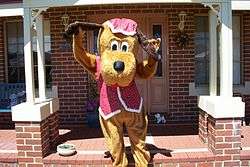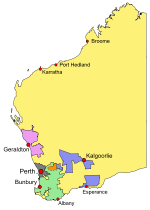GWN7
| GWN7 | |
|---|---|
 | |
| Launched | 10 March 1967 |
| Owned by | Prime Media Group |
| Picture format | 576i (SDTV) 16:9 |
| Audience share | 29.0% (2013, [1]) |
| Slogan | Gottaloveit |
| Country | Australia |
| Language | English |
| Broadcast area | Regional WA |
| Affiliates | Seven Network |
| Formerly called |
South West Telecasters (1967-1979) Golden West Network (1979-2011) |
| Website | gwn7.com.au |
Availability | |
| Terrestrial | |
| Freeview GWN7 owned (virtual) | 6 |
| Satellite | |
| VAST (virtual) | 6 |
GWN7 is an Australian television network owned by the Prime Media Group serving all of Western Australia outside of metropolitan Perth. It launched on 10 March 1967 as BTW-3 in Bunbury, where it is still based.[2] An affiliate of the Seven Network, it serves one of the largest geographic television markets in the world—almost one-third of the continent. The network's name, GWN, is an acronym of Golden West Network, the network's name from 1979 to when the current name was adopted in 2011.
History
Origins
GWN began life as a group of smaller, independent stations:
- 10 March 1967: BTW-3 Bunbury
- 28 August 1968: GSW-9 Mount Barker - relay
- 29 August 1974: GSW-10 Albany - relay
- 18 June 1971: VEW-8 Kalgoorlie
- 29 November 1971: VEW-3 Kambalda - relay
- 21 January 1977: GTW-11 Geraldton
Prior to these stations signing on, remote Western Australia had been one of the few areas of Australia without local television; the only television outlets in the area were relays of ABC Television out of Perth.
Jack Bendat purchased South West Telecasters (owner of BTW/GSW) in 1979, and changed the company's name to Golden West Network (GWN).[3]

GWN applied to broadcast an additional service on 31 October 1984, when the Australian Broadcasting Tribunal called for applications to broadcast to Christmas Island and the Cocos (Keeling) Islands via satellite as part of the Remote Commercial Television License (RCTS) scheme. GWN was granted the Remote Commercial Television License (RCTS) in June 1985[4] and the service went to air on 18 October 1986 using the call-sign WAW.
Not long after, GWN continued to expand within Western Australia, acquiring Mid-Western Television (owner of VEW-8 Kalgoorlie) in December 1985 for A$7 million,[5] and Geraldton Telecasters (owner of GTW-11) in March 1987 for an undisclosed amount.[6] The takeovers gave the network a monopoly over all commercial television services in regional Western Australia. In 1987, Bendat and Kerry Stokes merged their media interests into joint company BDC Investments.[7] Later that year, Northern Star Holdings purchased BDC for A$206 million.[8] Northern Star were forced to sell GWN to satisfy existing media regulations. GWN was sold back to Stokes in December 1988 for A$54 million,[9] who upgraded equipment throughout the network. In April 1990, the callsigns BTW and GSW were merged, to become SSW. During the late 1980s, GWN was promoted as GWN Satellite and aired programs from mostly the Nine Network plus a few from Seven and Ten with TVW's Seven News (from Perth) providing the national news link.
1990s to the 2000s
Kerry Stokes gained control of the Seven Network in 1995, and attempted to sell GWN to Seven in return for more shares. Seven Network shareholders agreed to the trade in April 1996 – a deal which would have seen Seven acquire GWN for A$72.8 million[10] thus becoming the regional network affiliate for Western Australia. The arrangement was called off when the Australian Competition and Consumer Commission (ACCC) found that a 15-year exclusive programming deal GWN made with the Nine Network was anti competitive and opposed the acquisition. The Seven Network subsequently dropped their plans to purchase GWN.[11] And as a result, the network soon ended its programming deal with Nine for exclusive broadcast of its shows in regional areas of the state.
Prime Television purchased GWN in November 1996 from Stokes for A$71 million.[12] Remote Western Australia was one of the few areas of regional Australia that was not aggregated, given its small population. This ended in 1997, when WIN Television was granted the rights to a second television license in regional Western Australia, ending GWN's monopoly of all three Australian commercial channels. In March 1999, GWN opted to become a sole Seven Network affiliate, in-line with its eastern sister, Prime Television. As a result, WIN Television WA picked up both the Nine Network and Network Ten affiliations.[13]
The network's transmission operations were moved from Bunbury to Prime Media Group's digital broadcast facility in Canberra in April 2005. Programming is delivered to regional Western Australia via a satellite feed.
A proposal for a third television station – a joint venture between GWN's parent company Prime Media Group and WIN Corporation – was submitted to the Australian Communications and Media Authority in 2006. Similar to Mildura Digital Television, the new channel will operate under a Section 38B licence,[14] as a Network Ten affiliate named Ten West.
2010 and beyond
The new decade saw the introduction of digital television, with the Central Wheatbelt, Kalgoorlie, Karratha and Mingenew digital transmitters launching on 10 June 2010. The broadcasters shared a single digital transmitter for GWN, WIN WA and the new Ten West in standard definition.[15]
On 15 January 2011, Prime Media Group reported that GWN and Prime were to rebrand to GWN7 and Prime7 respectively, in connection to their strong relations with the metropolitan stations of the Seven Network. Their news bulletins were quickly renamed as GWN7 News and Prime7 News. These bulletins were relaunched on 16 January 2011 at 5:57pm.[16]
Digital transmitter upgrades continued on 28 July 2011, with Bunbury and surrounds being introduced to the full suite of digital channels for the first time, including 7TWO and 7mate.[17] On 30 July 2011, the regional networks began broadcasting on the Viewer Access Satellite Television platform.[18]
Programming
Since becoming a full Seven affiliate, GWN7's on-air schedule has become almost identical to that of its metropolitan counterpart, TVW in Perth. Seven News Perth and Today Tonight are aired live across the network direct from Perth. GWN7 also produces a weeknightly local news service, GWN7 News, shown live at 5:30pm.[19] Since the network's inception it has featured a broad range of original regional programming, currently including the children's program Doopa's Club with Madelaine Collignon from Prime7 and station mascot Doopa Dog;[20] as well as community service strand GWN7 InfoNet, a series of short updates listing local community events.[21]
GWN7 News

GWN7 News (previously known as Golden West News or GWN News) is the network's regional news service.[19] Its main 30-minute program, airing live at 5:30pm on weeknights before Seven News Perth, deals primarily with local news and current affairs. As of March 2012, GWN7 produces the only dedicated local news program for regional Western Australia.[22]
The bulletin is produced and broadcast from GWN7's main studios in Bunbury with reporters and camera crews also based at newsrooms in Perth, Albany, Kalgoorlie-Boulder, Karratha, Geraldton and Broome, Western Australia.
Availability

GWN7 is available statewide in digital terrestrial and digital satellite format. The full suite of digital services, including 7TWO, 7mate, ishop tv and RACING.COM, are available in all areas with digital transmissions.
Below is a table showing the Logical Channel Numbers (LCN) for the full suite of digital services.
| LCN | Service |
|---|---|
| 6 | GWN7 |
| 62 | 7TWO |
| 63 | 7mate |
| 65 | ishop tv |
| 68 | RACING.COM |
Terrestrial
Digital terrestrial transmissions are available in all populated cities and major towns of regional Western Australia. Analog terrestrial services ceased transmission statewide on 25 June 2013.
Satellite
Digital satellite transmissions are available direct-to-home on the Viewer Access Satellite Television platform in areas that are not covered by adequate terrestrial transmissions.[18]
Logos
The Golden West Network became a network in 1986, with a shared logo produced and used across the regional stations, featuring the letters GWN inside an outlined oval surrounded by an orbiting ring.[23] This logo was used across the network until 1995, when a new logo was introduced with the removal of outlined oval surrounding the letters GWN.[23] Following this, 2001 saw the launch of a new simplified yellow logo, with the removal of the orbiting ring. This logo was launched concurrently with a similarly design logo on Prime Television.[23] Following the 2011 relaunch, a new logo was introduced which features the Seven Network logo. The relaunch logo featuring Seven Network was revised in 2013 from multi colour to be a single colour logo.
 1986–1995
1986–1995 1995–2001
1995–2001 2001–16 January 2011
2001–16 January 2011 16 January 2011 – present
16 January 2011 – present
See also
References
- ↑ http://www.regionaltam.com.au/?page_id=19&year=2013#
- ↑ Jenkins, Tom (17 November 1981). The South West's own TV station. -Golden West Network in Western-. In West Australian. (17 Nov 1981), supp.34.
- ↑ Golden West Network. (2011).[From South Western Telecasters Ltd] In Trove. Retrieved 13 July 2011, from http://nla.gov.au/nla.party-631450
- ↑ Earl, Greg (13 June 1985). "Golden West wins licence for remote TV by satellite". Australian Financial Review. p. 5.
- ↑ Lawson, Mark (28 November 1985). "Media portfolio sells 86pc stake in Mid-Western". Australian Financial Review. p. 24.
- ↑ Earl, Greg (17 March 1987). "Bendats buy fourth TV station". Australian Financial Review. p. 5.
- ↑ Power, Julie (21 April 1987). "This week... The market". Australian Financial Review. p. 25.
- ↑ Peers, Martin (10 August 1987). "Stokes makes a loss on TV deal". Australian Financial Review. p. 1.
- ↑ Frith, Damon (30 December 1987). "Northern Star finalises re-sale of Golden West". Australian Financial Review. p. 11.
- ↑ Jones, Megan (17 April 1996). "Seven yes to Golden West deal". The Age. p. 3.
- ↑ Anderson, Simon (5 June 1996). "Seven drops plan to buy Golden West". Australian Financial Review. p. 19.
- ↑ Kidman, Matthew (13 November 1996). "Prime buys Golden West". Sydney Morning Herald. p. 29.
- ↑ Schulze, Jane (12 January 1999). "Prime signs with Seven so WIN joins Nine, Ten". The Age. p. 2.
- ↑ Cairns, Samantha (14 November 2006). "Joint TV service". Kalgoorlie Miner. p. 1.
- ↑ Brown, Pam (11 June 2010). "Digital signal for viewers in Kalgoorlie". The West Australian. p. 5. Retrieved 8 July 2010.
|section=ignored (help) - ↑ Knox, David (15 January 2011). "Prime, GWN rebrand with 7". TV Tonight. Retrieved 4 April 2013.
- ↑ Knox, David (19 July 2011). "7TWO and 7mate join VAST in the West". TV Tonight. Retrieved 4 April 2013.
- 1 2 "Viewer Access Satellite Television service for Western Australia" (PDF). Digital Ready Taskforce (DBCDE). March 2013. Retrieved 4 April 2013.
- 1 2 "Prime Media Group: Prime7 Television". Prime Media Group. Retrieved 4 April 2013.
- ↑ "Doopa's Club – GWN7 – Yahoo!7". GWN7 on Yahoo!7. Retrieved 4 April 2013.
- ↑ "InfoNet – GWN7 – Yahoo!7". GWN7 on Yahoo!7. Retrieved 4 April 2013.
- ↑ Taylor, Paige (13 March 2012). "WIN WA regional TV news bulletins axed on poor ratings". The Australian. Retrieved 4 April 2013.
- 1 2 3 Brooklyn Ross-Hulands. "Golden West Network History". AusTVHistory. Retrieved 9 March 2008.